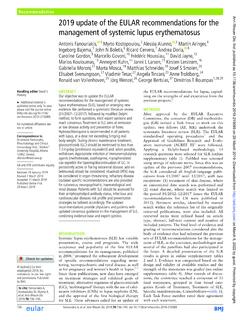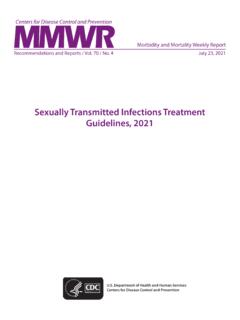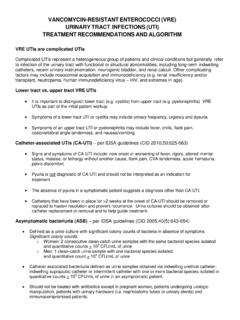Transcription of Recommendation Update of EULAR recommendations for …
1 Recommendation Ann Rheum Dis: first published as on 9 November 2016. Downloaded from on January 12, 2022 by guest. Protected by copyright. Update of EULAR recommendations for the treatment of systemic sclerosis Otylia Kowal-Bielecka,1 Jaap Fransen,2 Jerome Avouac,3 Mike Becker,4,5. Agnieszka Kulak,1 Yannick Allanore,3 Oliver Distler,5 Philip Clements,6. Maurizio Cutolo,7 Laszlo Czirjak,8 Nemanja Damjanov,9 Francesco del Galdo,10. Christopher P Denton,11 J rg H W Distler,12 Ivan Foeldvari,13 Kim Figelstone,14. Marc Frerix,15 Daniel E Furst,6 Serena Guiducci,16 Nicolas Hunzelmann,17. Dinesh Khanna,18 Marco Matucci-Cerinic,16 Ariane L Herrick,19,20. Frank van den Hoogen,2 Jacob M van Laar,21 Gabriela Riemekasten,22. Richard Silver,23 Vanessa Smith,24 Alberto Sulli,7 Ingo Tarner,15 Alan Tyndall,25. Joep Welling,26 Frederic Wigley,27 Gabriele Valentini,28 Ulrich A Walker,25. Francesco Zulian,29 Ulf M ller-Ladner,15 EUSTAR Coauthors Handling editor Tore K Kvien ABSTRACT INTRODUCTION.
2 The aim was to Update the 2009 European League Systemic sclerosis (SSc) is a connective tissue Additional material is published online only. To view against Rheumatism ( EULAR ) recommendations for the disease (CTD), which affects skin, blood vessels, please visit the journal online treatment of systemic sclerosis (SSc), with attention to heart, lungs, kidneys, gastrointestinal (GI) tract and (http:// dx. doi. org/ 10. 1136/ new therapeutic questions. Update of the previous musculoskeletal system. Involvement of internal annrheumdis- 2016- 209909). treatment recommendations was performed according to organs results in signi cant morbidity and mortality EULAR standard operating procedures. The task force of patients with SSc. Because of the clinical com- For numbered affiliations see end of article. consisted of 32 SSc clinical experts from Europe and plexity and heterogeneity of SSc, it is very challen- the USA, 2 patients nominated by the pan-European ging to treat this Establishing the rst Correspondence to patient association for SSc (Federation of European European League against Rheumatism ( EULAR ).)
3 Professor Otylia Kowal-Bielecka, Scleroderma Associations (FESCA)), a clinical recommendations for the treatment of SSc in 2009. Department of Rheumatology epidemiologist and 2 research fellows. All centres from was therefore a milestone for improving care of and Internal Medicine, Medical the EULAR Scleroderma Trials and Research group were patients with SSc and they were well received by University of Bialystok, Ul. M. Sklodowskiej-Curie 24A, invited to submit and select clinical questions the international community of scleroderma Bialystok 15-276, Poland; concerning SSc treatment using a Delphi approach. 3 In view of several recent developments otylia. bielecka@ gmail. com Accordingly, 46 clinical questions addressing 26 regarding treatment of SSc-related internal organ different interventions were selected for systematic involvement, the need of an Update of the 2009. Received 18 May 2016. Revised 22 August 2016 literature review.
4 The new recommendations were based EULAR recommendations has been recognised by Accepted 9 October 2016 on the available evidence and developed in a the EULAR Scleroderma Trials and Research group Published Online First consensus meeting with clinical experts and patients. (EUSTAR) and acknowledged by the EULAR . 9 November 2016 The procedure resulted in 16 recommendations being Following EULAR standardised operating proce- developed (instead of 14 in 2009) that address dures, an ad hoc expert committee was established treatment of several SSc-related organ complications: by EULAR and 5 As in previous recom- Raynaud's phenomenon (RP), digital ulcers (DUs), mendations, the global community of SSc experts pulmonary arterial hypertension (PAH), skin and lung cooperating within EUSTAR was disease, scleroderma renal crisis and gastrointestinal Based on the published evidence and expert involvement. Compared with the 2009 opinion, 16 updated recommendations regarding recommendations , the 2016 recommendations include pharmacological treatment of SSc-speci c organ phosphodiesterase type 5 (PDE-5) inhibitors for the involvement were formulated.
5 It should be recog- treatment of SSc-related RP and DUs, riociguat, new nised that the eld of management of patients with aspects for endothelin receptor antagonists, prostacyclin SSc is larger than pharmacological management analogues and PDE-5 inhibitors for SSc-related PAH. alone. Management of SSc also includes (early). New recommendations regarding the use of uoxetine diagnosis of the disease, early diagnosis of internal for SSc-related RP and haematopoietic stem cell organ involvement, identi cation of patients at risk transplantation for selected patients with rapidly of development of new organ complications and progressive SSc were also added. In addition, several deterioration of the disease as well as non- comments regarding other treatments addressed in pharmacological treatments, of which most of are clinical questions and suggestions for the SSc research beyond the scope of this project. There are also agenda were formulated.
6 These updated data-derived several ( potential) drugs, including new promising and consensus-derived recommendations will help therapies that might be helpful in management of To cite: Kowal-Bielecka O, rheumatologists to manage patients with SSc in an patients with SSc that could not be included in Fransen J, Avouac J, evidence-based way. These recommendations also give these evidence-based recommendations due to et al. Ann Rheum Dis directions for future clinical research in SSc. insuf cient data at present. The actual recommen- 2017;76:1327 1339. dations are aimed to guide pharmacological Kowal-Bielecka O, et al. Ann Rheum Dis 2017;76:1327 1339. 1327. Recommendation Ann Rheum Dis: first published as on 9 November 2016. Downloaded from on January 12, 2022 by guest. Protected by copyright. treatment of SSc-speci c organ involvement. These recommen- between 1966 and, as agreed by the panel, until 30 September dations are not meant to replace the physician's clinical judge- 2014 in PubMed, EMBASE, the Cochrane Database for ment or the patient-physician shared decision.
7 They should be meta-analyses and the Cochrane Controlled Trials Register as viewed in light of the clinician's understanding of the individual well as the 2012 and 2013 EULAR and American College of patient and the clinician's and patients' judgement of the Rheumatology (ACR) congress abstract archives. For clinical balance between the ef cacy and toxicity of a treatment . questions already included in the existing recommendations the Although some treatment -related toxicities are mentioned in the same strategy was followed, searching from February 2007 to text of the recommendations , it still is the responsibility of the 30 September 2014. A standardised search strategy was used for physician to recognise and monitor all possible toxicities/side all clinical questions (see online supplementary table S2). effects according to the information supplied by the producer Medical subject heading (MeSH) search (exploded) was used for and all other available sources.
8 PubMed and a keyword search was used for 2012 2014 or if the MeSH term was not available. For every clinical question, METHODS the publications found were screened for eligibility by reading Design title and abstract. The reference lists of meta-analyses, reviews These recommendations are an Update of the 2009 EULAR or systematic reviews were examined to nd additional studies. recommendations for treatment of Evidence for existing For details regarding selection of studies, classifying and recommendations was updated with new evidence published evaluation of evidence as well as data extraction, see online since then, all existing recommendations were newly judged and supplement material. reformulated if necessary. Existing recommendations could also be removed, for instance, when a certain (class of ) drugs was recommendations withdrawn from the market. New evidence-based recommenda- The evidence of the individual studies was combined to achieve tions were added.
9 A Recommendation in agreement with the Grades of Recommendation , Assessment, Development, and Evaluation Expert panel (GRADE) 7 Accordingly, an evidence pro le and a An expert panel was established with 32 clinical experts in the summary of outcomes table were made for every clinical ques- eld of SSc (29 rheumatologists, 1 dermatologist, 2 paediatric tion by AK or MB. Using these results, a set of draft recommen- rheumatologists with expertise in juvenile SSc), 2 patients with dations were prepared by OK-B, JF, UML, YA and OD. The SSc (KF, JW) and 1 clinical epidemiologist ( JF) overall repre- draft recommendations were sent to the expert panel in advance senting 11 countries. The clinical experts had to be internation- of the second face-to-face consensus meeting in October 2014. ally recognised as specialists in SSc with several years of Draft recommendations were presented one-by-one together experience in diagnosing and treating patients with this disease.
10 With the evidence pro le and outcome tables, moderated by JF. The two patient partners were nominated by the pan-European Based on the nominal group technique, all recommendations patient association for SSc (FESCA). Potential con icts of inter- were discussed, could be reformulated and a level of evidence est were declared by all participants. There was no involvement was attached, until consensus was reached among all participat- of third parties in the entire process of making these ing experts. recommendations . RESULTS. Selection process of clinical questions The procedure as described above resulted in 16 recommenda- To create a comprehensive list of topics of interest, the clinical tions being developed (instead of 14 in 2009). These recommen- experts from all EUSTAR centres were asked by email to con- dations address treatment of several SSc-related organ tribute clinical questions relevant to the pharmacological treat- complications: Raynaud's phenomenon (RP), digital ulcers ment of SSc.










